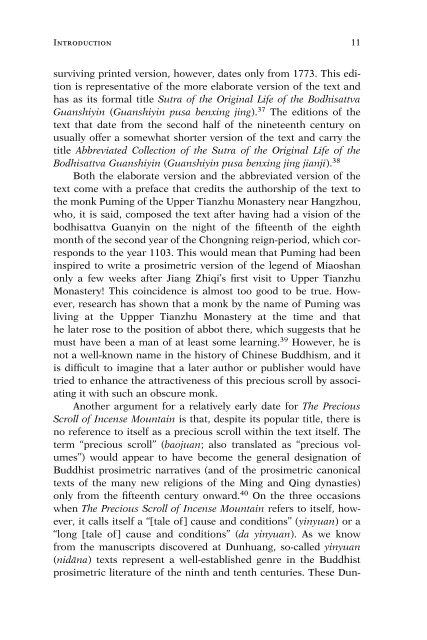Two Precious Scroll Narratives of Guanyin and Her ... - Khamkoo
Two Precious Scroll Narratives of Guanyin and Her ... - Khamkoo
Two Precious Scroll Narratives of Guanyin and Her ... - Khamkoo
You also want an ePaper? Increase the reach of your titles
YUMPU automatically turns print PDFs into web optimized ePapers that Google loves.
Introduction 11<br />
surviving printed version, however, dates only from 1773. This edition<br />
is representative <strong>of</strong> the more elaborate version <strong>of</strong> the text <strong>and</strong><br />
has as its formal title Sutra <strong>of</strong> the Original Life <strong>of</strong> the Bodhisattva<br />
Guanshiyin (Guanshiyin pusa benxing jing). 37 The editions <strong>of</strong> the<br />
text that date from the second half <strong>of</strong> the nineteenth century on<br />
usually <strong>of</strong>fer a somewhat shorter version <strong>of</strong> the text <strong>and</strong> carry the<br />
title Abbreviated Collection <strong>of</strong> the Sutra <strong>of</strong> the Original Life <strong>of</strong> the<br />
Bodhisattva Guanshiyin (Guanshiyin pusa benxing jing jianji). 38<br />
Both the elaborate version <strong>and</strong> the abbreviated version <strong>of</strong> the<br />
text come with a preface that credits the authorship <strong>of</strong> the text to<br />
the monk Puming <strong>of</strong> the Upper Tianzhu Monastery near Hangzhou,<br />
who, it is said, composed the text after having had a vision <strong>of</strong> the<br />
bodhisattva <strong>Guanyin</strong> on the night <strong>of</strong> the fifteenth <strong>of</strong> the eighth<br />
month <strong>of</strong> the second year <strong>of</strong> the Chongning reign-period, which corresponds<br />
to the year 1103. This would mean that Puming had been<br />
inspired to write a prosimetric version <strong>of</strong> the legend <strong>of</strong> Miaoshan<br />
only a few weeks after Jiang Zhiqi’s first visit to Upper Tianzhu<br />
Monastery! This coincidence is almost too good to be true. However,<br />
research has shown that a monk by the name <strong>of</strong> Puming was<br />
living at the Uppper Tianzhu Monastery at the time <strong>and</strong> that<br />
he later rose to the position <strong>of</strong> abbot there, which suggests that he<br />
must have been a man <strong>of</strong> at least some learning. 39 However, he is<br />
not a well-known name in the history <strong>of</strong> Chinese Buddhism, <strong>and</strong> it<br />
is difficult to imagine that a later author or publisher would have<br />
tried to enhance the attractiveness <strong>of</strong> this precious scroll by associating<br />
it with such an obscure monk.<br />
Another argument for a relatively early date for The <strong>Precious</strong><br />
<strong>Scroll</strong> <strong>of</strong> Incense Mountain is that, despite its popular title, there is<br />
no reference to itself as a precious scroll within the text itself. The<br />
term ‘‘precious scroll’’ (baojuan; also translated as ‘‘precious volumes’’)<br />
would appear to have become the general designation <strong>of</strong><br />
Buddhist prosimetric narratives (<strong>and</strong> <strong>of</strong> the prosimetric canonical<br />
texts <strong>of</strong> the many new religions <strong>of</strong> the Ming <strong>and</strong> Qing dynasties)<br />
only from the fifteenth century onward. 40 On the three occasions<br />
when The <strong>Precious</strong> <strong>Scroll</strong> <strong>of</strong> Incense Mountain refers to itself, however,<br />
it calls itself a ‘‘[tale <strong>of</strong>] cause <strong>and</strong> conditions’’ (yinyuan) ora<br />
‘‘long [tale <strong>of</strong>] cause <strong>and</strong> conditions’’ (da yinyuan). As we know<br />
from the manuscripts discovered at Dunhuang, so-called yinyuan<br />
(nidāna) texts represent a well-established genre in the Buddhist<br />
prosimetric literature <strong>of</strong> the ninth <strong>and</strong> tenth centuries. These Dun-

















